Dissertation: Analyzing Security Issues in Software-Defined Networking
VerifiedAdded on 2023/04/23
|11
|1556
|251
Thesis and Dissertation
AI Summary
This dissertation provides an overview of Software-Defined Networking (SDN) and its associated security issues. It explores the concept of SDN, its benefits, and the challenges related to security, scalability, and manageability. The research investigates security issues such as data confidentiality, lack of trust, and vulnerabilities in administrative stations. A descriptive study approach was applied, collecting primary data from IT employees of HP, Defcon, and Cisco. Quantitative data analysis techniques, including SPSS, were used to analyze the data. The study concludes that while SDN offers advantages like centralized control and programmability, it also presents security risks that need to be addressed through measures like Role-Based Access Control and secure protocols. Desklib provides access to this dissertation and other study resources.
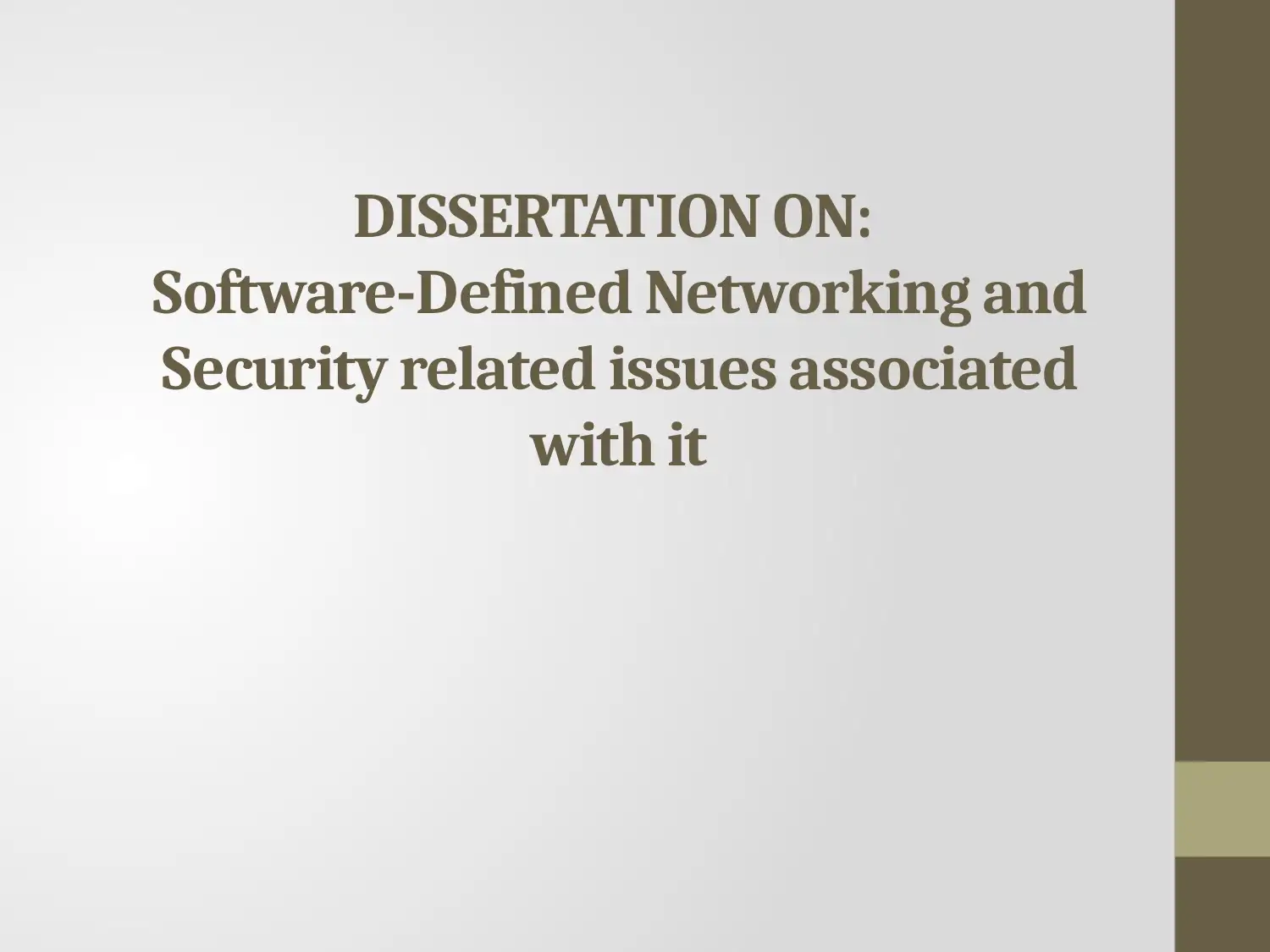
DISSERTATION ON:
Software-Defined Networking and
Security related issues associated
with it
Software-Defined Networking and
Security related issues associated
with it
Paraphrase This Document
Need a fresh take? Get an instant paraphrase of this document with our AI Paraphraser
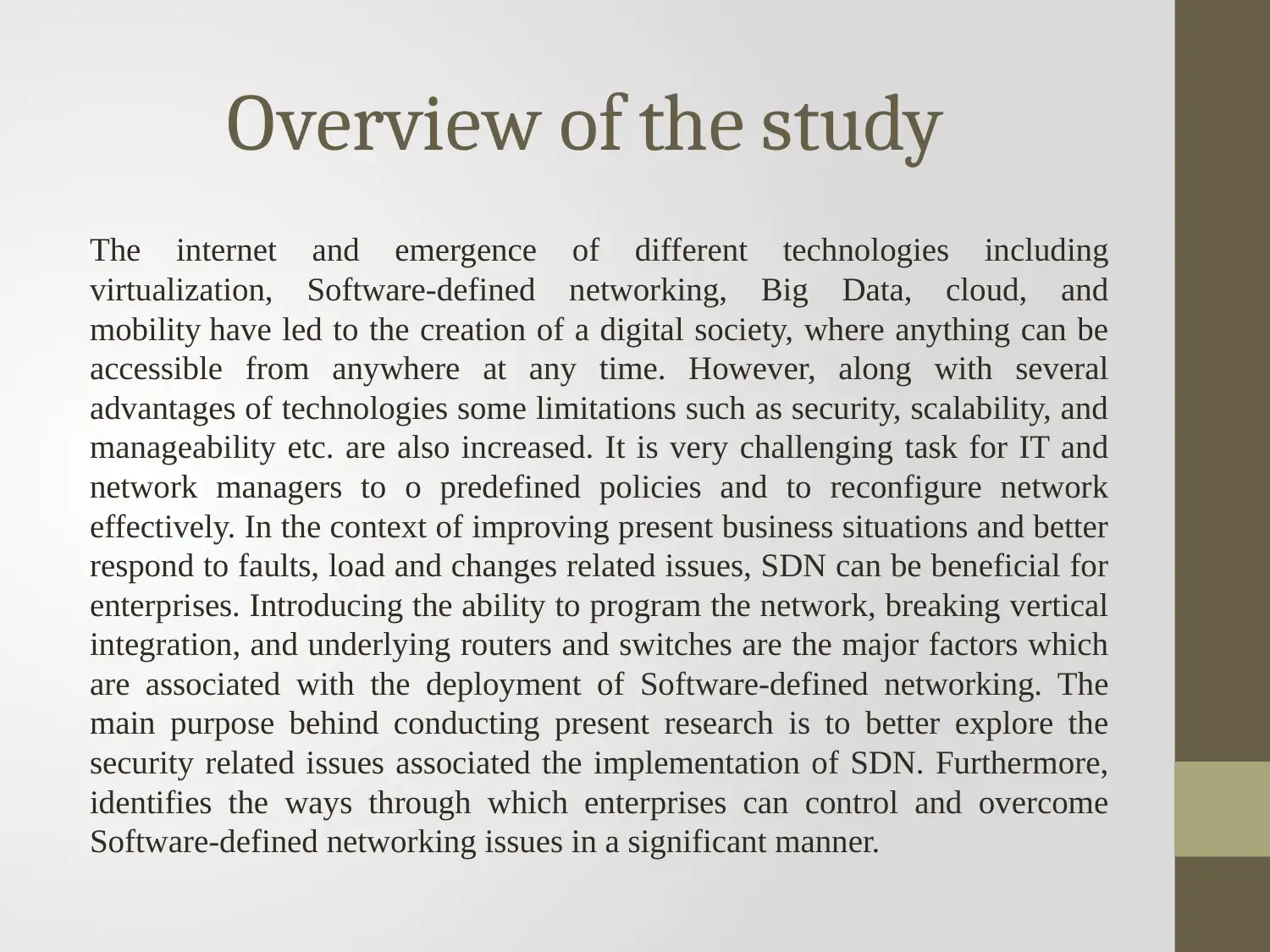
Overview of the study
The internet and emergence of different technologies including
virtualization, Software-defined networking, Big Data, cloud, and
mobility have led to the creation of a digital society, where anything can be
accessible from anywhere at any time. However, along with several
advantages of technologies some limitations such as security, scalability, and
manageability etc. are also increased. It is very challenging task for IT and
network managers to o predefined policies and to reconfigure network
effectively. In the context of improving present business situations and better
respond to faults, load and changes related issues, SDN can be beneficial for
enterprises. Introducing the ability to program the network, breaking vertical
integration, and underlying routers and switches are the major factors which
are associated with the deployment of Software-defined networking. The
main purpose behind conducting present research is to better explore the
security related issues associated the implementation of SDN. Furthermore,
identifies the ways through which enterprises can control and overcome
Software-defined networking issues in a significant manner.
The internet and emergence of different technologies including
virtualization, Software-defined networking, Big Data, cloud, and
mobility have led to the creation of a digital society, where anything can be
accessible from anywhere at any time. However, along with several
advantages of technologies some limitations such as security, scalability, and
manageability etc. are also increased. It is very challenging task for IT and
network managers to o predefined policies and to reconfigure network
effectively. In the context of improving present business situations and better
respond to faults, load and changes related issues, SDN can be beneficial for
enterprises. Introducing the ability to program the network, breaking vertical
integration, and underlying routers and switches are the major factors which
are associated with the deployment of Software-defined networking. The
main purpose behind conducting present research is to better explore the
security related issues associated the implementation of SDN. Furthermore,
identifies the ways through which enterprises can control and overcome
Software-defined networking issues in a significant manner.
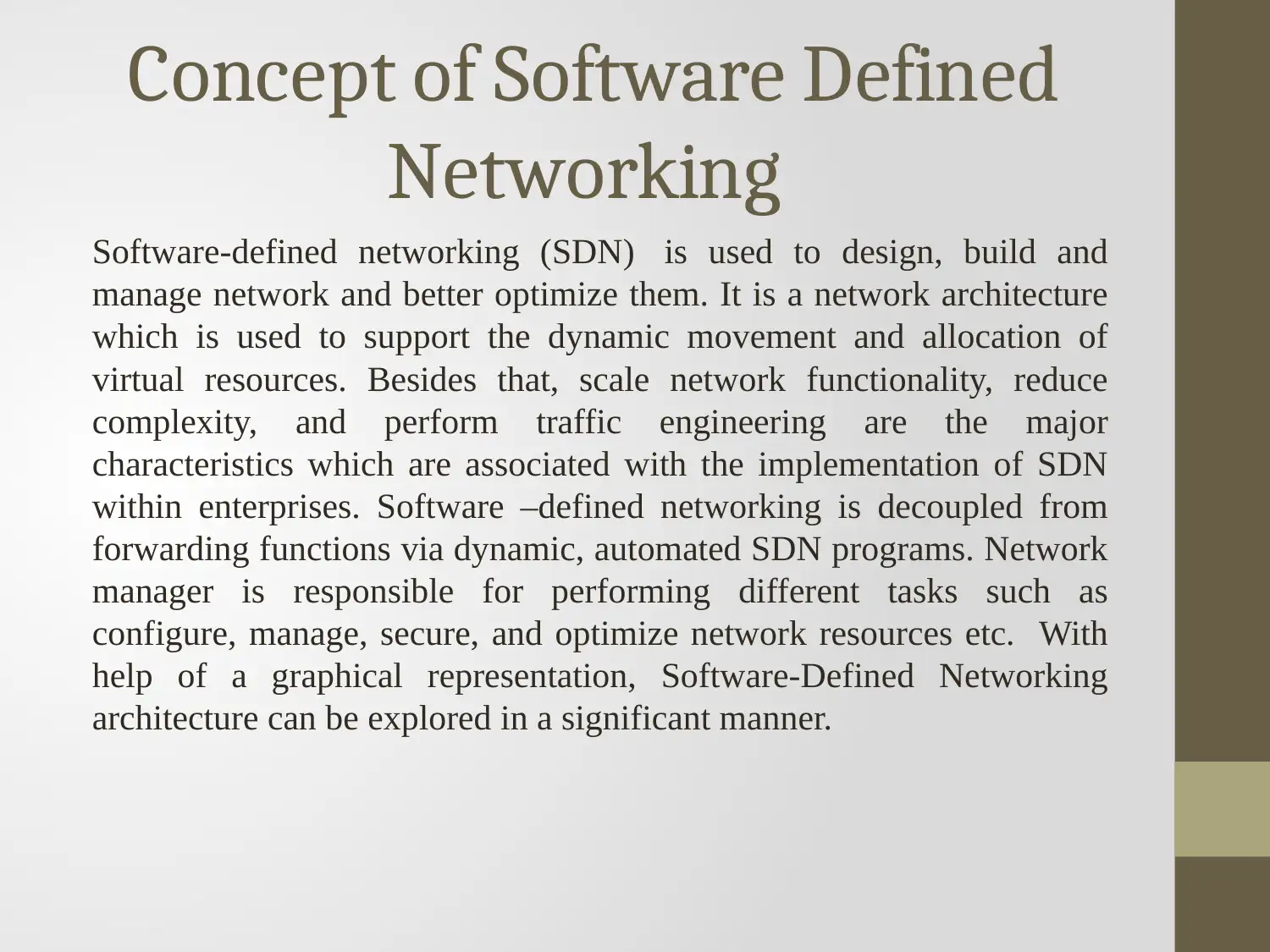
Concept of Software Defined
Networking
Software-defined networking (SDN) is used to design, build and
manage network and better optimize them. It is a network architecture
which is used to support the dynamic movement and allocation of
virtual resources. Besides that, scale network functionality, reduce
complexity, and perform traffic engineering are the major
characteristics which are associated with the implementation of SDN
within enterprises. Software –defined networking is decoupled from
forwarding functions via dynamic, automated SDN programs. Network
manager is responsible for performing different tasks such as
configure, manage, secure, and optimize network resources etc. With
help of a graphical representation, Software-Defined Networking
architecture can be explored in a significant manner.
Networking
Software-defined networking (SDN) is used to design, build and
manage network and better optimize them. It is a network architecture
which is used to support the dynamic movement and allocation of
virtual resources. Besides that, scale network functionality, reduce
complexity, and perform traffic engineering are the major
characteristics which are associated with the implementation of SDN
within enterprises. Software –defined networking is decoupled from
forwarding functions via dynamic, automated SDN programs. Network
manager is responsible for performing different tasks such as
configure, manage, secure, and optimize network resources etc. With
help of a graphical representation, Software-Defined Networking
architecture can be explored in a significant manner.
⊘ This is a preview!⊘
Do you want full access?
Subscribe today to unlock all pages.

Trusted by 1+ million students worldwide
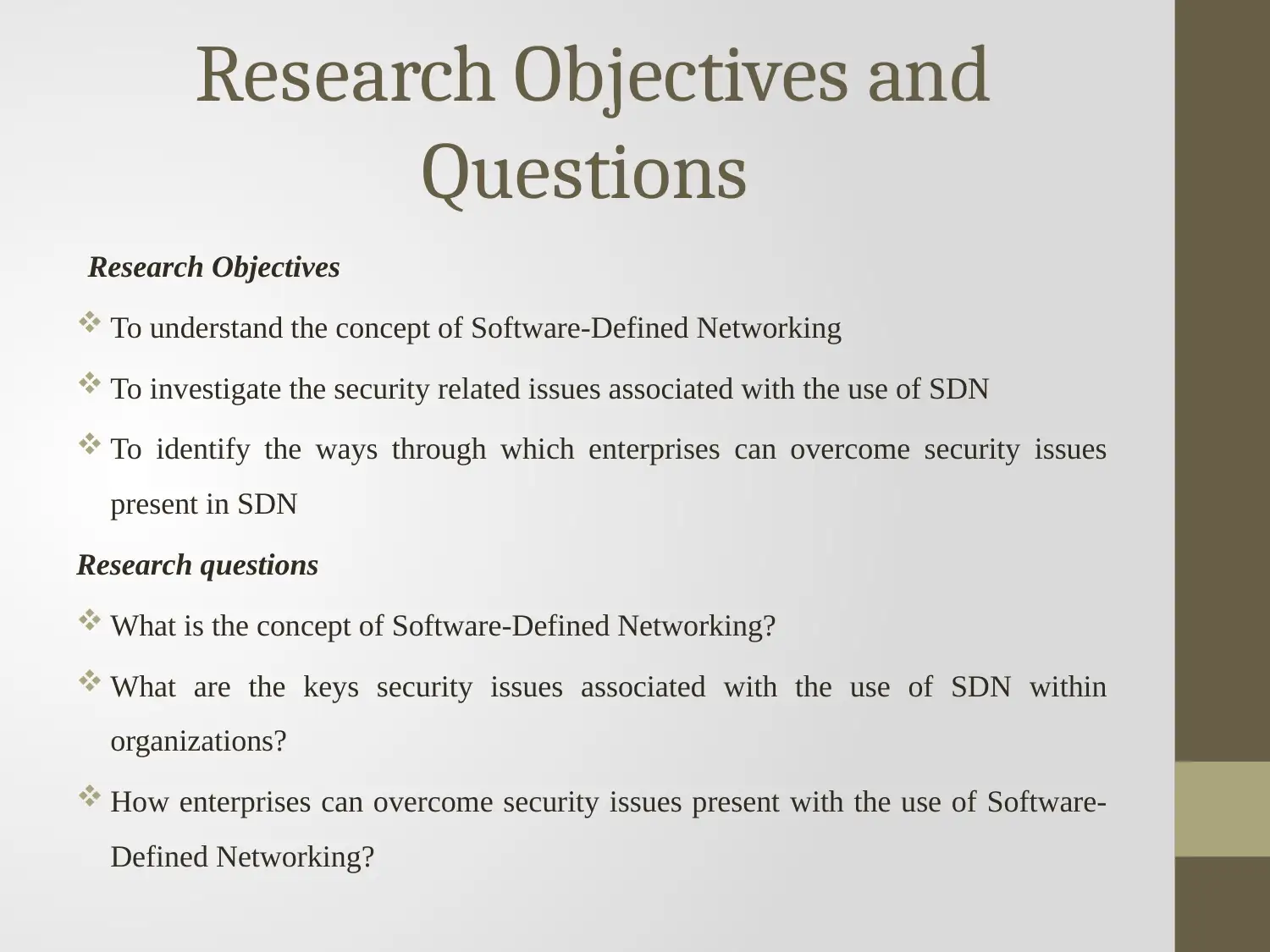
Research Objectives and
Questions
Research Objectives
To understand the concept of Software-Defined Networking
To investigate the security related issues associated with the use of SDN
To identify the ways through which enterprises can overcome security issues
present in SDN
Research questions
What is the concept of Software-Defined Networking?
What are the keys security issues associated with the use of SDN within
organizations?
How enterprises can overcome security issues present with the use of Software-
Defined Networking?
Questions
Research Objectives
To understand the concept of Software-Defined Networking
To investigate the security related issues associated with the use of SDN
To identify the ways through which enterprises can overcome security issues
present in SDN
Research questions
What is the concept of Software-Defined Networking?
What are the keys security issues associated with the use of SDN within
organizations?
How enterprises can overcome security issues present with the use of Software-
Defined Networking?
Paraphrase This Document
Need a fresh take? Get an instant paraphrase of this document with our AI Paraphraser
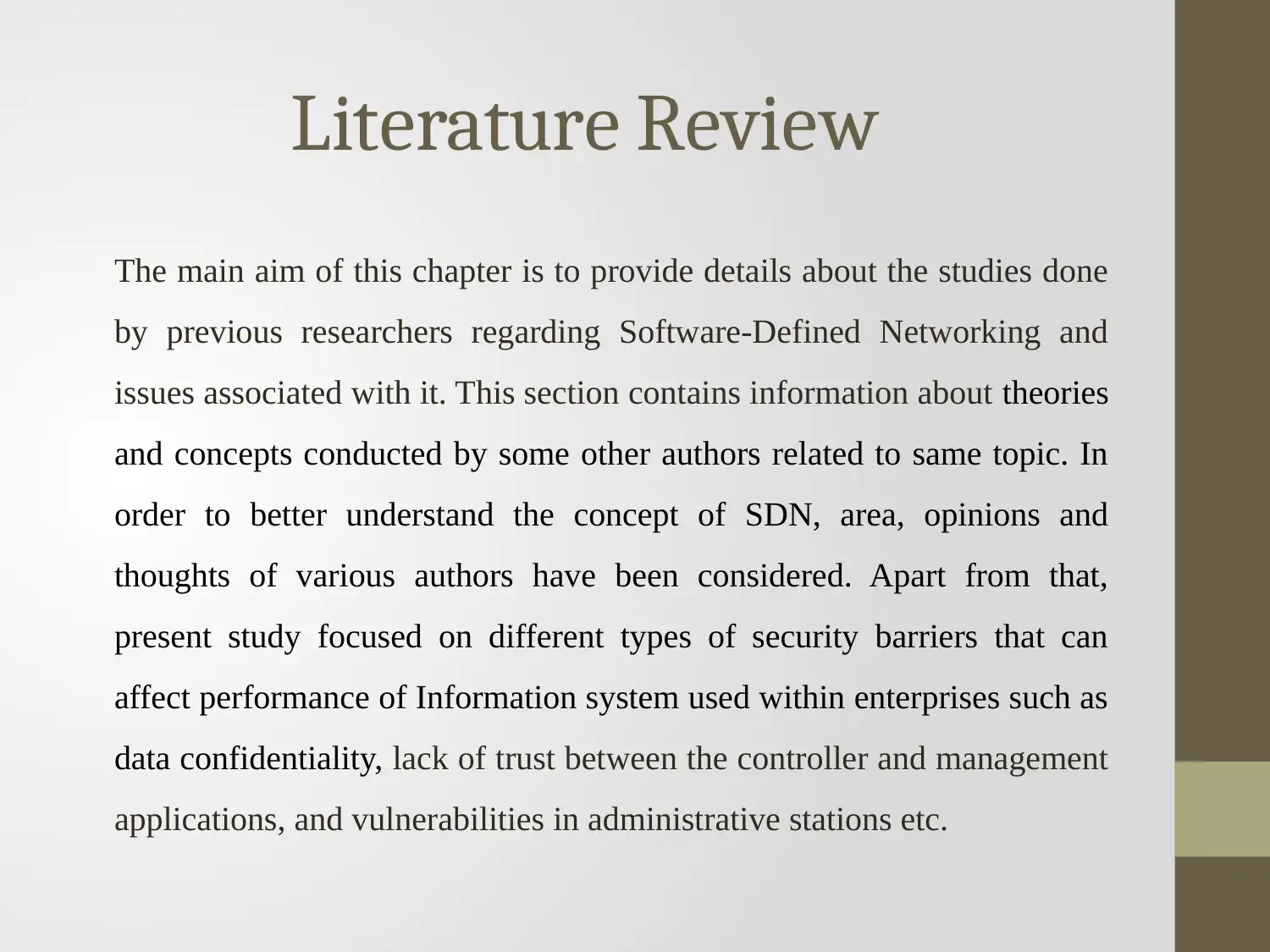
Literature Review
The main aim of this chapter is to provide details about the studies done
by previous researchers regarding Software-Defined Networking and
issues associated with it. This section contains information about theories
and concepts conducted by some other authors related to same topic. In
order to better understand the concept of SDN, area, opinions and
thoughts of various authors have been considered. Apart from that,
present study focused on different types of security barriers that can
affect performance of Information system used within enterprises such as
data confidentiality, lack of trust between the controller and management
applications, and vulnerabilities in administrative stations etc.
The main aim of this chapter is to provide details about the studies done
by previous researchers regarding Software-Defined Networking and
issues associated with it. This section contains information about theories
and concepts conducted by some other authors related to same topic. In
order to better understand the concept of SDN, area, opinions and
thoughts of various authors have been considered. Apart from that,
present study focused on different types of security barriers that can
affect performance of Information system used within enterprises such as
data confidentiality, lack of trust between the controller and management
applications, and vulnerabilities in administrative stations etc.
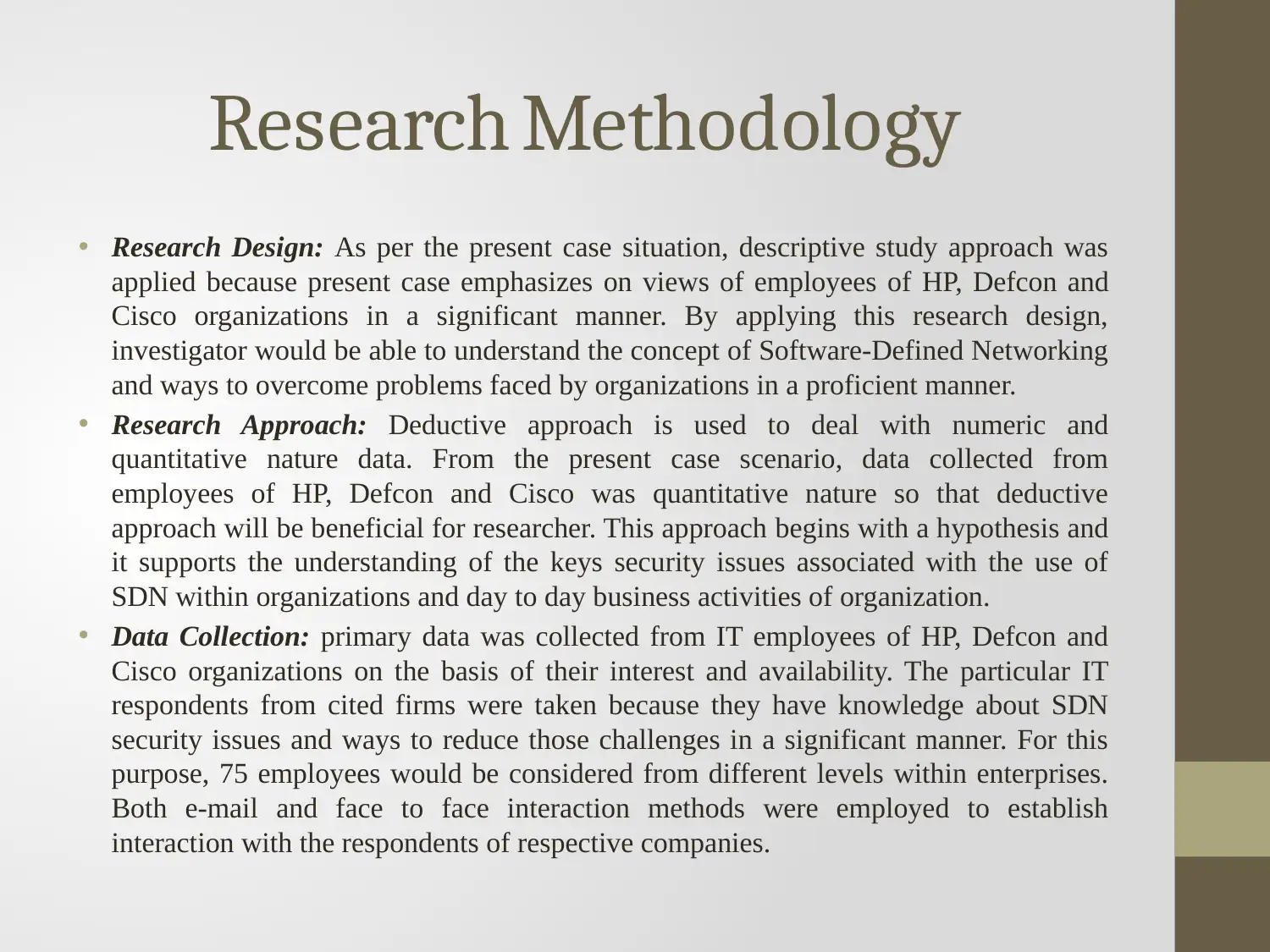
Research Methodology
• Research Design: As per the present case situation, descriptive study approach was
applied because present case emphasizes on views of employees of HP, Defcon and
Cisco organizations in a significant manner. By applying this research design,
investigator would be able to understand the concept of Software-Defined Networking
and ways to overcome problems faced by organizations in a proficient manner.
• Research Approach: Deductive approach is used to deal with numeric and
quantitative nature data. From the present case scenario, data collected from
employees of HP, Defcon and Cisco was quantitative nature so that deductive
approach will be beneficial for researcher. This approach begins with a hypothesis and
it supports the understanding of the keys security issues associated with the use of
SDN within organizations and day to day business activities of organization.
• Data Collection: primary data was collected from IT employees of HP, Defcon and
Cisco organizations on the basis of their interest and availability. The particular IT
respondents from cited firms were taken because they have knowledge about SDN
security issues and ways to reduce those challenges in a significant manner. For this
purpose, 75 employees would be considered from different levels within enterprises.
Both e-mail and face to face interaction methods were employed to establish
interaction with the respondents of respective companies.
• Research Design: As per the present case situation, descriptive study approach was
applied because present case emphasizes on views of employees of HP, Defcon and
Cisco organizations in a significant manner. By applying this research design,
investigator would be able to understand the concept of Software-Defined Networking
and ways to overcome problems faced by organizations in a proficient manner.
• Research Approach: Deductive approach is used to deal with numeric and
quantitative nature data. From the present case scenario, data collected from
employees of HP, Defcon and Cisco was quantitative nature so that deductive
approach will be beneficial for researcher. This approach begins with a hypothesis and
it supports the understanding of the keys security issues associated with the use of
SDN within organizations and day to day business activities of organization.
• Data Collection: primary data was collected from IT employees of HP, Defcon and
Cisco organizations on the basis of their interest and availability. The particular IT
respondents from cited firms were taken because they have knowledge about SDN
security issues and ways to reduce those challenges in a significant manner. For this
purpose, 75 employees would be considered from different levels within enterprises.
Both e-mail and face to face interaction methods were employed to establish
interaction with the respondents of respective companies.
⊘ This is a preview!⊘
Do you want full access?
Subscribe today to unlock all pages.

Trusted by 1+ million students worldwide
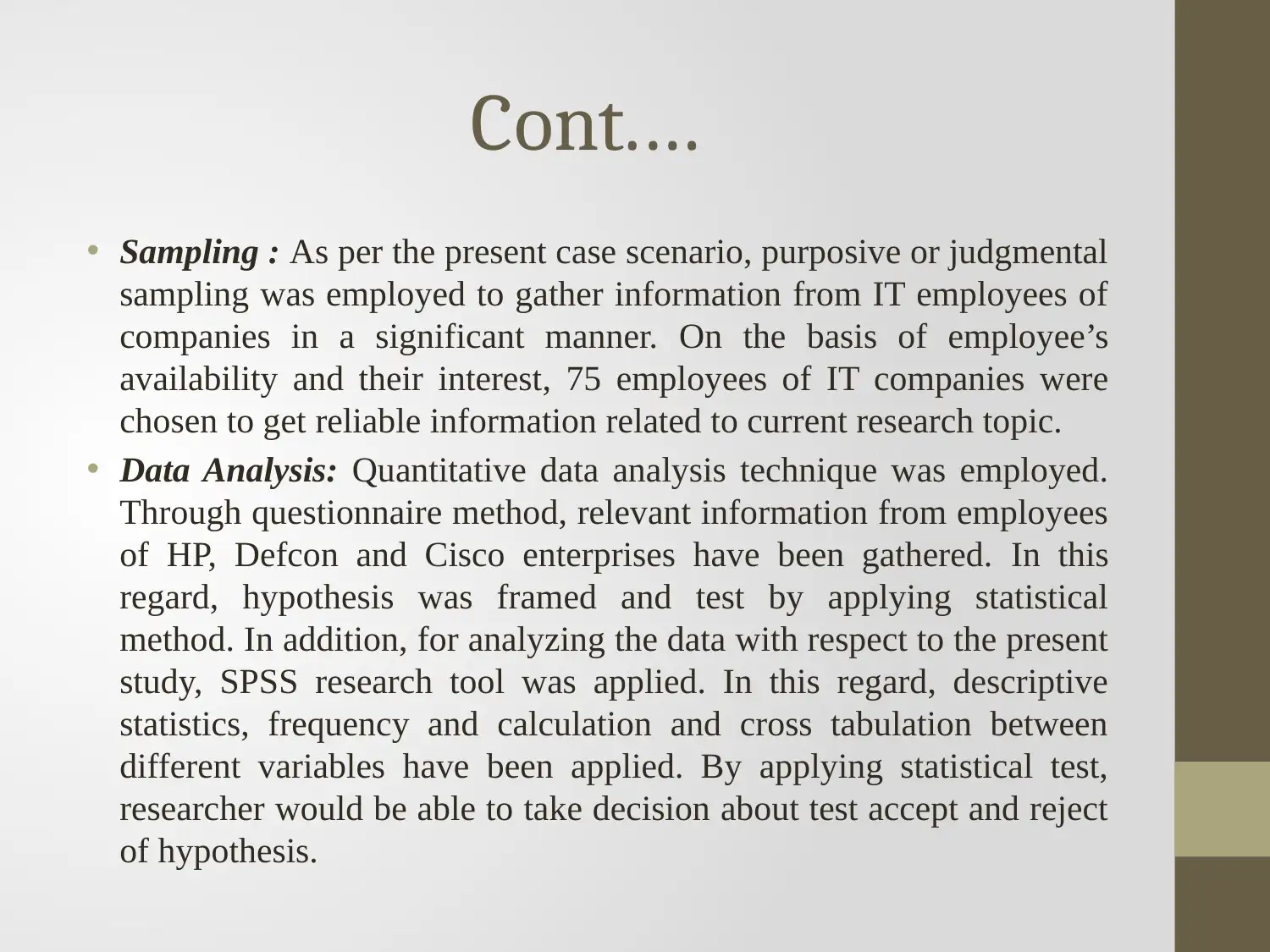
Cont.…
• Sampling : As per the present case scenario, purposive or judgmental
sampling was employed to gather information from IT employees of
companies in a significant manner. On the basis of employee’s
availability and their interest, 75 employees of IT companies were
chosen to get reliable information related to current research topic.
• Data Analysis: Quantitative data analysis technique was employed.
Through questionnaire method, relevant information from employees
of HP, Defcon and Cisco enterprises have been gathered. In this
regard, hypothesis was framed and test by applying statistical
method. In addition, for analyzing the data with respect to the present
study, SPSS research tool was applied. In this regard, descriptive
statistics, frequency and calculation and cross tabulation between
different variables have been applied. By applying statistical test,
researcher would be able to take decision about test accept and reject
of hypothesis.
• Sampling : As per the present case scenario, purposive or judgmental
sampling was employed to gather information from IT employees of
companies in a significant manner. On the basis of employee’s
availability and their interest, 75 employees of IT companies were
chosen to get reliable information related to current research topic.
• Data Analysis: Quantitative data analysis technique was employed.
Through questionnaire method, relevant information from employees
of HP, Defcon and Cisco enterprises have been gathered. In this
regard, hypothesis was framed and test by applying statistical
method. In addition, for analyzing the data with respect to the present
study, SPSS research tool was applied. In this regard, descriptive
statistics, frequency and calculation and cross tabulation between
different variables have been applied. By applying statistical test,
researcher would be able to take decision about test accept and reject
of hypothesis.
Paraphrase This Document
Need a fresh take? Get an instant paraphrase of this document with our AI Paraphraser
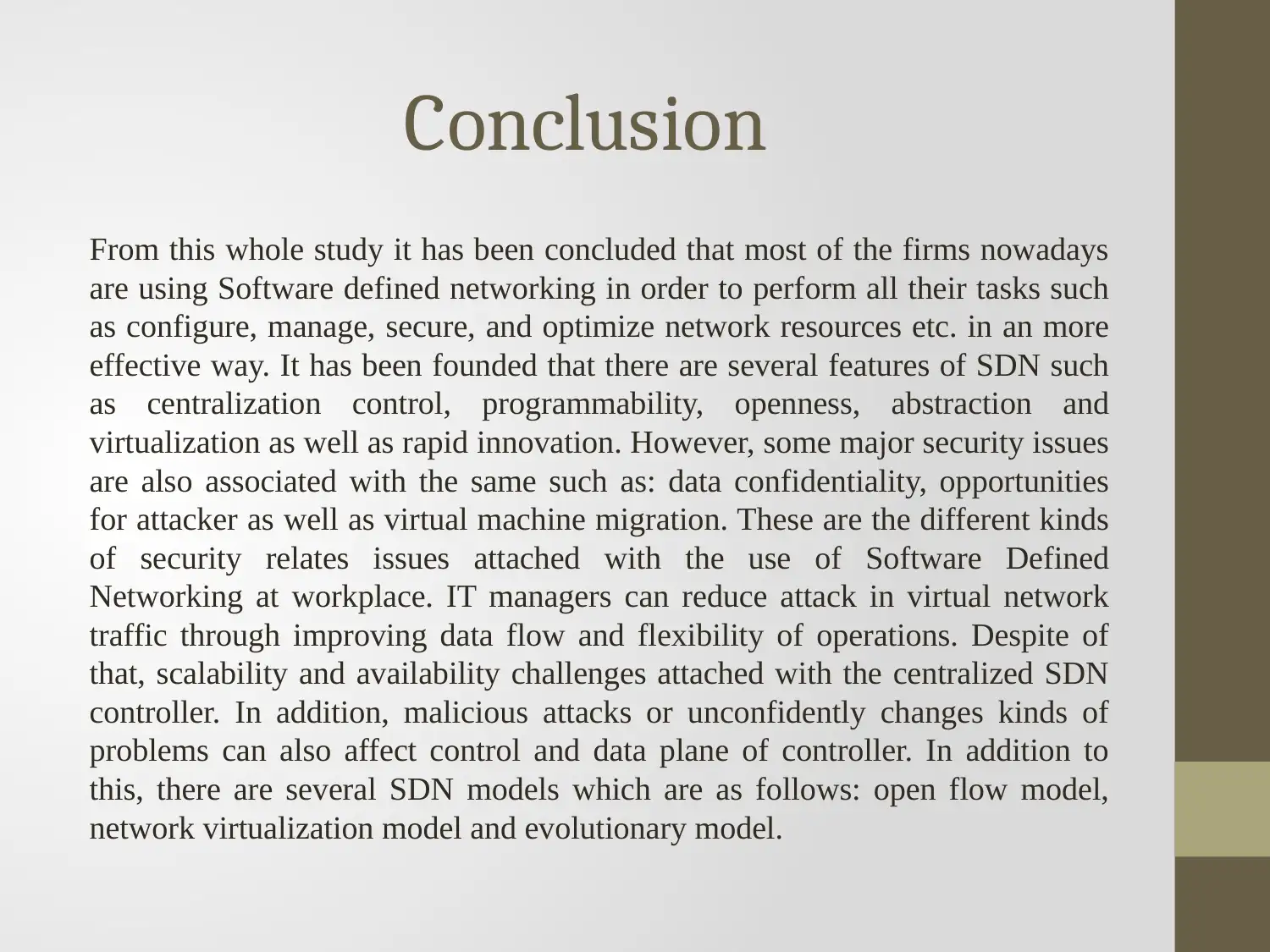
Conclusion
From this whole study it has been concluded that most of the firms nowadays
are using Software defined networking in order to perform all their tasks such
as configure, manage, secure, and optimize network resources etc. in an more
effective way. It has been founded that there are several features of SDN such
as centralization control, programmability, openness, abstraction and
virtualization as well as rapid innovation. However, some major security issues
are also associated with the same such as: data confidentiality, opportunities
for attacker as well as virtual machine migration. These are the different kinds
of security relates issues attached with the use of Software Defined
Networking at workplace. IT managers can reduce attack in virtual network
traffic through improving data flow and flexibility of operations. Despite of
that, scalability and availability challenges attached with the centralized SDN
controller. In addition, malicious attacks or unconfidently changes kinds of
problems can also affect control and data plane of controller. In addition to
this, there are several SDN models which are as follows: open flow model,
network virtualization model and evolutionary model.
From this whole study it has been concluded that most of the firms nowadays
are using Software defined networking in order to perform all their tasks such
as configure, manage, secure, and optimize network resources etc. in an more
effective way. It has been founded that there are several features of SDN such
as centralization control, programmability, openness, abstraction and
virtualization as well as rapid innovation. However, some major security issues
are also associated with the same such as: data confidentiality, opportunities
for attacker as well as virtual machine migration. These are the different kinds
of security relates issues attached with the use of Software Defined
Networking at workplace. IT managers can reduce attack in virtual network
traffic through improving data flow and flexibility of operations. Despite of
that, scalability and availability challenges attached with the centralized SDN
controller. In addition, malicious attacks or unconfidently changes kinds of
problems can also affect control and data plane of controller. In addition to
this, there are several SDN models which are as follows: open flow model,
network virtualization model and evolutionary model.
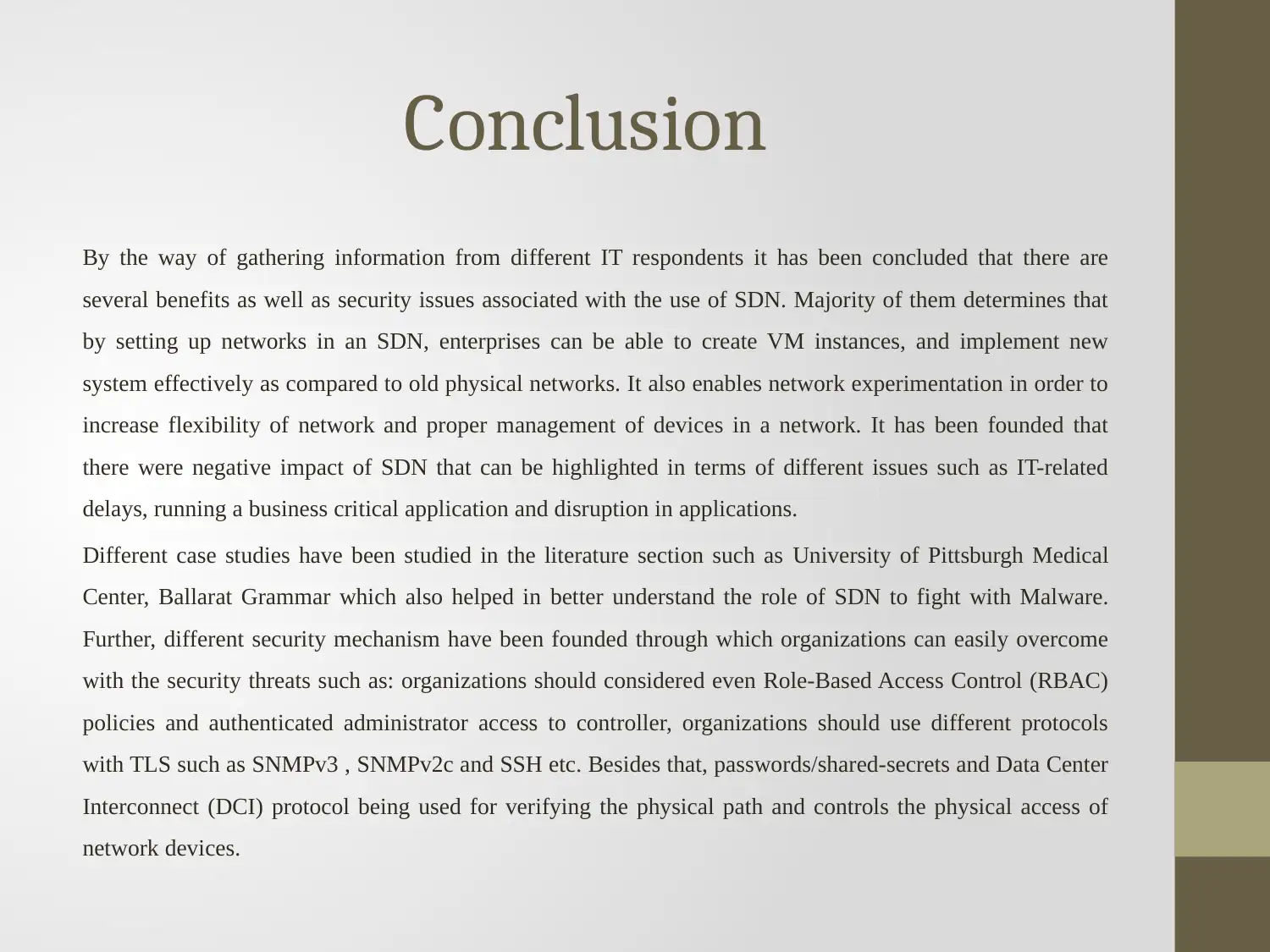
Conclusion
By the way of gathering information from different IT respondents it has been concluded that there are
several benefits as well as security issues associated with the use of SDN. Majority of them determines that
by setting up networks in an SDN, enterprises can be able to create VM instances, and implement new
system effectively as compared to old physical networks. It also enables network experimentation in order to
increase flexibility of network and proper management of devices in a network. It has been founded that
there were negative impact of SDN that can be highlighted in terms of different issues such as IT-related
delays, running a business critical application and disruption in applications.
Different case studies have been studied in the literature section such as University of Pittsburgh Medical
Center, Ballarat Grammar which also helped in better understand the role of SDN to fight with Malware.
Further, different security mechanism have been founded through which organizations can easily overcome
with the security threats such as: organizations should considered even Role-Based Access Control (RBAC)
policies and authenticated administrator access to controller, organizations should use different protocols
with TLS such as SNMPv3 , SNMPv2c and SSH etc. Besides that, passwords/shared-secrets and Data Center
Interconnect (DCI) protocol being used for verifying the physical path and controls the physical access of
network devices.
By the way of gathering information from different IT respondents it has been concluded that there are
several benefits as well as security issues associated with the use of SDN. Majority of them determines that
by setting up networks in an SDN, enterprises can be able to create VM instances, and implement new
system effectively as compared to old physical networks. It also enables network experimentation in order to
increase flexibility of network and proper management of devices in a network. It has been founded that
there were negative impact of SDN that can be highlighted in terms of different issues such as IT-related
delays, running a business critical application and disruption in applications.
Different case studies have been studied in the literature section such as University of Pittsburgh Medical
Center, Ballarat Grammar which also helped in better understand the role of SDN to fight with Malware.
Further, different security mechanism have been founded through which organizations can easily overcome
with the security threats such as: organizations should considered even Role-Based Access Control (RBAC)
policies and authenticated administrator access to controller, organizations should use different protocols
with TLS such as SNMPv3 , SNMPv2c and SSH etc. Besides that, passwords/shared-secrets and Data Center
Interconnect (DCI) protocol being used for verifying the physical path and controls the physical access of
network devices.
⊘ This is a preview!⊘
Do you want full access?
Subscribe today to unlock all pages.

Trusted by 1+ million students worldwide
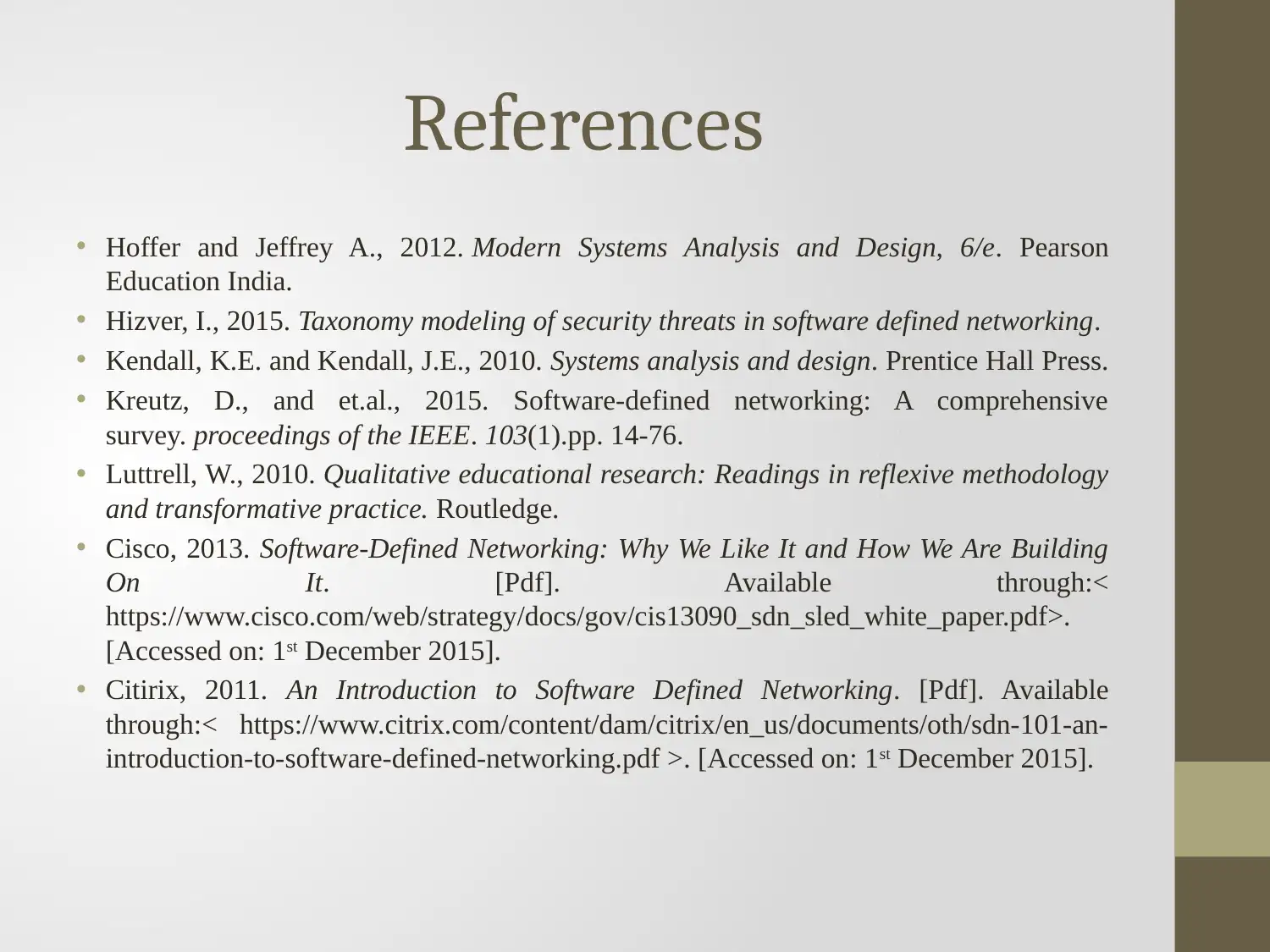
References
• Hoffer and Jeffrey A., 2012. Modern Systems Analysis and Design, 6/e. Pearson
Education India.
• Hizver, I., 2015. Taxonomy modeling of security threats in software defined networking.
• Kendall, K.E. and Kendall, J.E., 2010. Systems analysis and design. Prentice Hall Press.
• Kreutz, D., and et.al., 2015. Software-defined networking: A comprehensive
survey. proceedings of the IEEE. 103(1).pp. 14-76.
• Luttrell, W., 2010. Qualitative educational research: Readings in reflexive methodology
and transformative practice. Routledge.
• Cisco, 2013. Software-Defined Networking: Why We Like It and How We Are Building
On It. [Pdf]. Available through:<
https://www.cisco.com/web/strategy/docs/gov/cis13090_sdn_sled_white_paper.pdf>.
[Accessed on: 1st December 2015].
• Citirix, 2011. An Introduction to Software Defined Networking. [Pdf]. Available
through:< https://www.citrix.com/content/dam/citrix/en_us/documents/oth/sdn-101-an-
introduction-to-software-defined-networking.pdf >. [Accessed on: 1st December 2015].
• Hoffer and Jeffrey A., 2012. Modern Systems Analysis and Design, 6/e. Pearson
Education India.
• Hizver, I., 2015. Taxonomy modeling of security threats in software defined networking.
• Kendall, K.E. and Kendall, J.E., 2010. Systems analysis and design. Prentice Hall Press.
• Kreutz, D., and et.al., 2015. Software-defined networking: A comprehensive
survey. proceedings of the IEEE. 103(1).pp. 14-76.
• Luttrell, W., 2010. Qualitative educational research: Readings in reflexive methodology
and transformative practice. Routledge.
• Cisco, 2013. Software-Defined Networking: Why We Like It and How We Are Building
On It. [Pdf]. Available through:<
https://www.cisco.com/web/strategy/docs/gov/cis13090_sdn_sled_white_paper.pdf>.
[Accessed on: 1st December 2015].
• Citirix, 2011. An Introduction to Software Defined Networking. [Pdf]. Available
through:< https://www.citrix.com/content/dam/citrix/en_us/documents/oth/sdn-101-an-
introduction-to-software-defined-networking.pdf >. [Accessed on: 1st December 2015].
Paraphrase This Document
Need a fresh take? Get an instant paraphrase of this document with our AI Paraphraser

Thanks…
1 out of 11
Related Documents
Your All-in-One AI-Powered Toolkit for Academic Success.
+13062052269
info@desklib.com
Available 24*7 on WhatsApp / Email
![[object Object]](/_next/static/media/star-bottom.7253800d.svg)
Unlock your academic potential
Copyright © 2020–2025 A2Z Services. All Rights Reserved. Developed and managed by ZUCOL.





